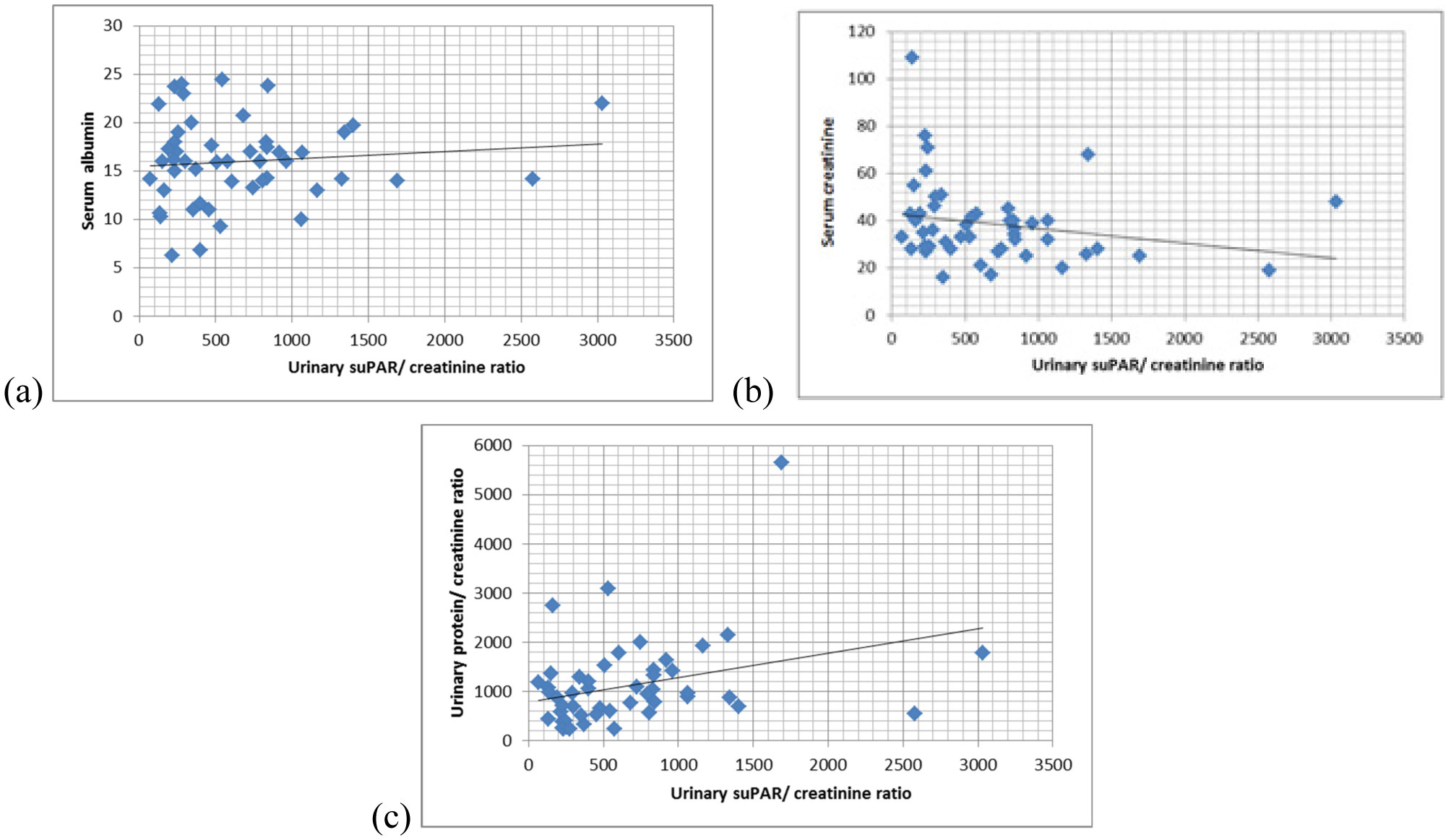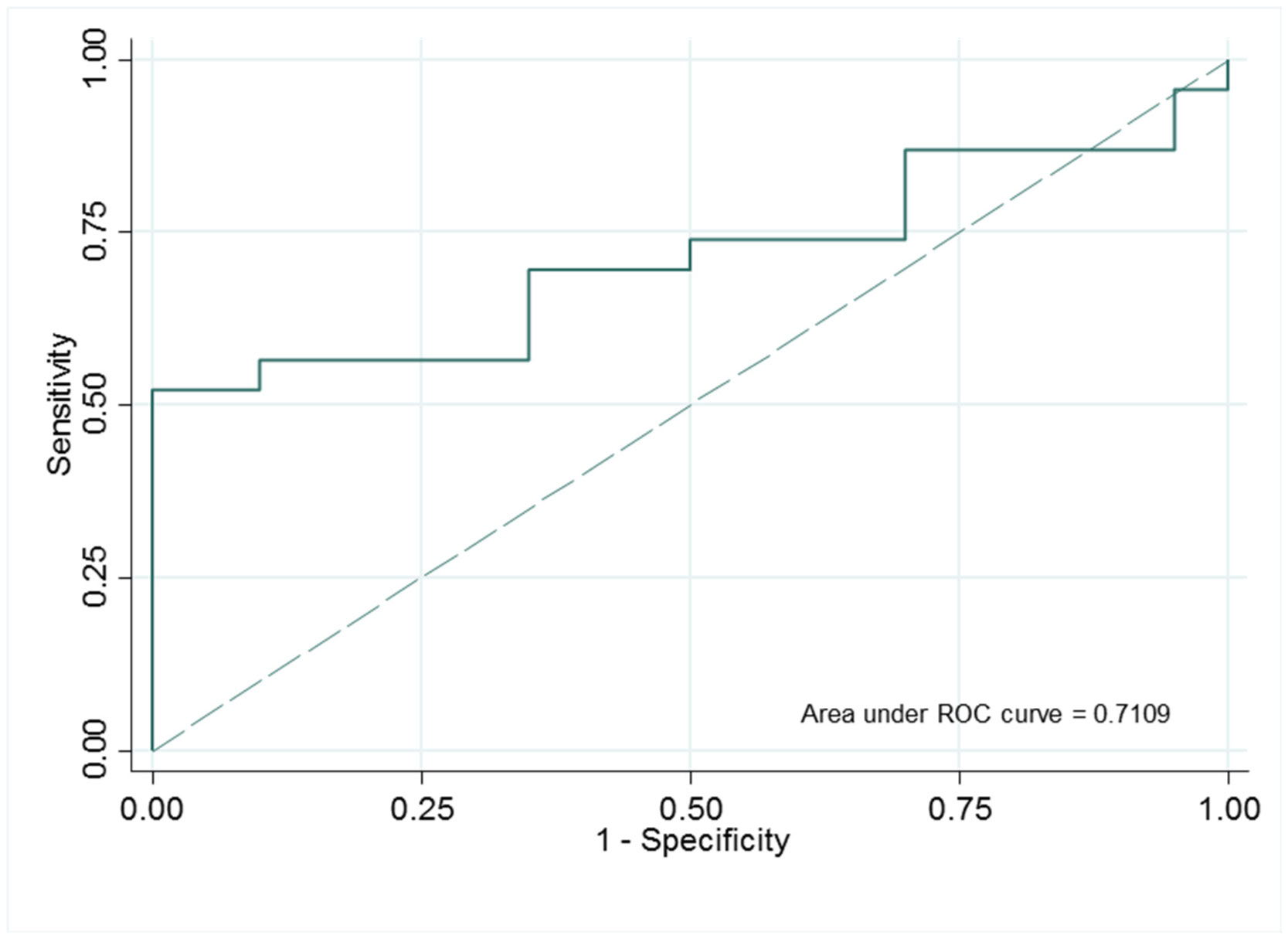1.
Introduction
Nephrotic syndrome is a chronic disease that is frequent relapses and intractable to steroid treatment. The main lesions of pediatric NS are minimal change disease (MCD) and focal segmental glomerulosclerosis (FSGS). Steroid resistant-NS is often seen in FSGS, it is often resistant and mostly progresses to end-stage renal disease [1],[2]. Recent studies reported that soluble urokinase plasminogen activator receptor, known as suPAR has roles in diagnosis as well as prognosis the response to steroid treatment of FSGS.
The results in these author studies also suggested that uPAR might be involved in the removal of podocytes and the separation of the glomerular basement membrane. uPAR is is a multidomain glycoprotein tethered to the cell membrane with a glycosylphosphotidylinositol (GPI) anchor. In the healthy tissue, there is a restriction of uPAR expression in the membrane. However, uPAR is strongly expressed in various cell types in pathophysiological processes such as osteoblasts during bone resorption or in macrophages, vascular smooth muscle cells, and endothelial cells [3] suPAR is a circulating form of uPAR. suPAR produces several direct effects on podocytes, including down-regulation of nephrin and podocin which occurs after activation of αvβ3-integrin known as a receptor or co-receptor for suPAR [4]. There are several lines of evidence showing that suPAR produces several direct pathogenic effects on podocytes that are mediated by binding of suPAR to cell-surface αvβ3-integrin. These include activation of tyrosine kinases such as Src, increased generation of reactive oxygen species, disordering of slit diaphragm proteins such as podocin, and increased surface expression and altered gating of TRPC6 channels [5],[6]. Mutations of TRPC6 are seen in many autosomal dominant forms of familial FSGS, and TRPC6 expression is increased in glomeruli from patients with glomerular diseases including primary FSGS [5].
Segarra (2014) [7], Palacios (2013) [8], Huang (2014) [9] demonstrated that urinary suPAR increased in the primary FSGS group and related to the severity of this disease. Urinary and serum suPAR concentrations are useful indicators of therapeutic response in primary NS patients, and help distinguish MCD from FSGS in the post-treatment period. In addition, serum and urine suPAR were associated with a long-term response to treatment in primary NS [10].
The previous studies demonstrated these advantages of urinary suPAR: First, urinary suPAR is adjusted based on the urinary suPAR/creatinine ratio, so it reduces the effect of glomerular filtration rate on suPAR concentration. Second, suPAR could be produced by damaged podocytes, so the urinary suPAR concentration would include both serum suPAR and the suPAR from the podocytes. That helps separate FSGS damage more clearly than other non-renal diseases. Finally, subunits of suPAR that want to cause glomerular damage must pass through the glomerular membrane, so the quantification of suPAR in the urine will reflect more clearly the relationship between suPAR and glomerular damage [6],[8],[9],[11].
In view of the above observations, our study was performed to investigate whether there is a relationship between the urinary suPAR concentration and the responsiveness to steroid therapy in childhood NS.
Our study's aims included: (1) assessing the ability of predicting the steroid responsiveness of the pretreatment urinary suPAR, and (2) evaluating urinary suPAR's ability in differentiating steroid sensitive NS from steroid resistant NS.
2.
Materials and methods
2.1. Study population
This study was approved by the ethics committee of Hue University of Medicine and Pharmacy. A total of 112 children who came to the Hue Pediatric Center of Hue Central hospital and Pediatric Departement of Hue University of Medicine and Pharmacy hospital, Vietnam from January 2019 to January 2021 were recruited for our study.
Secondary NS such as lupus nephritis, Henoch-Schonlein purpura nephritis, glomerulonephritis post infection were excluded.
They included 49 initial NS (first diagnosed), 43 relapsed NS and 30 healthy children for control group.
(1) The initial NS patients were diagnosed by The Kidney Disease: Improving global outcomes (KDIGO) 2012 criteria: proteinuria/creatininuria ratio >200 mg/mmol in the same urine sample, serum albumin <25 g/l and edema [12].
The urinary suPAR was measured before the initial NS patients were treated.
A total of 49 initial NS patients were treated with prednisolone with the dose of 2 mg/kg/day during 6 weeks. After that, depending on the patients' response, prednisolone was reduced to 1.5 mg/kg on alternate days during 6 weeks, then it was gradually tapered by 1/6 dose weekly. The protocol of this study was proposed by the Pediatric Clinical Book of Hue University of Medicine and Pharmacy based on the guideline of The American Academy of Pediatrics [13].
The treatment responsiveness of each patient was assessed at 6 weeks and at 6 months.
Definition of treatment responsiveness:
Steroid sensitive NS (remission) is the attainment of urine dipstick of nil or trace for three consecutive days in the initial 6-week course of steroid therapy. Steroid resistant NS is the absence of remission despite therapy with daily prednisolone at a dose 2 mg/kg/day for 6 weeks [12]. There are 2 types of steroid resistance. The initial resistance is the lack of remission at the initial 6-week course. The late resistance is the initially steroid sensitive NS, but show steroid resistance during subsequent relapse.
(2) A total of 43 relapsed NS who were diagnosed NS and were treated previously, at the research time, had a presence of urinary protein/creatinine ratio ≥200 mg/mmol. The urinary suPAR was measured at the time they relapsed. These patients were catergorized into 2 groups based on their steroid responsiveness at the research time: (1) SSNS includes the patients infrequent relapses or steroid dependent NS. (2) SRNS includes the patients both initial steroid resistance and late steroid resistance.
(3) The control group: we selected 30 children who visited pediatric out-patient clinic for general health check into control group. These children got 10 parameter urine test as a routine test during examination and all of them had negative results for proteinuria and hematuria. These children had found no any specific disease finally.
2.2. Sample collection and suPAR measurements
Freshly voided urine samples were separated by centrifugation at 1000 g for 20 minutes and stored at −80 °C until analysis, using a Human suPAR ELISA kit (Abbexa Ltd, Cambridge, UK) following the manufacturer's protocol. The range of suPAR ELISA kit is from 0.156 ng/ml to 10 ng/ml. When the initial measurements were outside the state range of the assay, samples might be analysed at 1:6 dilution so that the expected concentration fell within the kit's range.
Protein, creatinine in urine (in the same sample with suPAR), serum albumin and serum creatinine were measured by Roche's kits, following the manufacturer's protocol.
2.3. Statistical analysis
Statistical analysis was performed using statistical software SPSS 16.0. Comparasion of quantitative parameters was assessed using the non- parametric test between two non-normally distributed variables or one normally with one non-normally distributed variable. Spearman's correlation test was used to measure the correlation between two non-normally distributed variables or one normally with one non-normally distributed variable. A ROC curve analysis was used to evaluate the ability of suPAR to predict SRNS. All statistical analyses were two-tailed and p < 0.05 was considered as significant.
2.4. Ethical approval and informed consent
The study was approved by the Research Ethics Committee of Hue University of Medicine and Pharmacy (IBR number: 7/NCKH-HUMP). Each patient and their parent gave written.
3.
Results
The demographic and paraclinical characteristics of patients is listed in Table 1. The boy/girl ratio was 5/1. In the initial NS, 1–6 years old group was the most common group, accounted for 69.4%. In relapsed NS, the percentage of three groups of age (1–6 years old, 7–10 years old and 11–16 years old) were quite similar. We also observed that the urinary protein/creatinine ratio in the initial NS was higher than in the relapsed NS and inversely with serum albumin (p < 0.05). The urinary suPAR concentration are shown in Table 2. The urinary suPAR was presented with two units: pg/ml and pg/µmol. Urinary suPAR concentration in the control group was lower than that in the NS group. The urinary suPAR/creatinine ratio in the control group, the initial NS and the relapsed NS were, respectively, 248 (88–609) pg/µmol, 509 (237–840) pg/µmol and 628 (386–1015) pg/µmol. There was a significant difference in terms of urinary suPAR/creatinine ratio between the control group and the NS group (p < 0.004).
The relationship between pretreatment urinary suPAR and laboratory data is shown in Figure 1 and Figure 2. There was no correlation between the urinary suPAR/creatinine ratio and serum albumin or serum creatinine. There was a moderately positive correlation between urinary protein/creatinine ratio and urinary suPAR/creatinine ratio (p < 0.05). Table 3 shows the correlation between urinary suPAR/creatinine ratio and the treatment responsiveness. The rate of SRNS was 8.9% at 6 weeks of treatment, and increased to 12.2% at 6 months of treatment. The concentration of urinary suPAR/creatinine ratio in SRNS group was higher than that in SSNS group but there was no significant difference between urinary suPAR/creatinine ratio with steroid responsiveness at 6 weeks and at 6 months of treatment (p > 0.05).
Urinary suPAR/creatinine ratio in SRNS was significantly higher than that in SSNS (Table 4). Value of urinary suPAR in predicting steroid resistance in NS patients is presented in Figure 3. Urinary suPAR/creatinine concentration of 950 pg/µmol was the best cut-off to distinguish SRNS from SSNS with AUC 0.7 (95%CI 0.65–0.91), Se 73.9% Sp 89.5%.
4.
Discussion
We measured the urinary suPAR concentration in the control group, the initial NS group and the relapsed NS group. The results of our study showed that: urinary suPAR concentration in control group was lower than that in initial NS and that in relapsed NS. There was a significant difference in terms of urinary suPAR/creatinine ratio between the control group and the NS group.
At the time of writing, there has been very few studies on suPAR concentration in children, especially on urinary suPAR, thus comparative results are quite limited. The assay for suPAR is designed for research and is not standardized for routine clinical use. Therefore, results based on different commercial assays may lead to different quantitative results [14],[15]. These different value of suPAR concentration on pediatric NS are listed in Table 5.
Previous studies on suPAR in children is rather limited. For adults, Sun et al. (2019) reported a concentration of urinary suPAR/creatinine ratio of 307.9 (216.5–480.2) pg/µmol and 183.6 (103.9–228.8) pg/µmol in the NS group and in the control group, respectively [20]. suPAR molecules with the molecular weight of 22–45 kDa which filter through the glomerular membrane, exist in the urine and are affected by the dilution of the urine, therefore, similarly to the previous studies, our study adjusted urinary suPAR concentration for the ratio of urinary suPAR to urinary creatinine.
We investigated the correlation between urinary suPAR and the subclinical factors such as urinary protein/creatinine ratio, serum albumin and serum creatinine in the NS group. In the relapsed NS, some children received albumin infusions during the treatment period, so that we did not compare serum albumin in this group. Our results showed that urinary suPAR/creatinine ratio did not correlate with serum creatinine (p > 0.05), serum albumin (p > 0.05) in both initial NS and relapsed NS, however, it had a moderately positive correlation with urinary protein/ creatinine ratio (p < 0.05). The studies on serum suPAR by Bock (2013) and by Peng (2014) indicated that there was no the relationship between serum albumin, serum creatinine, CRP and proteinuria with serum suPAR [16],[17]. Fujimoto's study found that suPAR urinary positively correlated with proteinuria (rs = 0.5, p = 0.003), and it did not correlate with glomerular filtration rate [10]. Huang et al. stated that urinary suPAR was positively associated with proteinuria (rs = 0.287, p = 0.024), inversely related to serum albumin (r = −0.269, p = 0.034) in patients with primary FSGS, but it was not relevant in patients with MCD (r = 0.192, p = 0.529), membrane nephritis (r = −0.189, p = 0.399), and secondary FSGS (r = −0.264, p = 0.384). There was no relationship between glomerular filtration rate and urinary suPAR/creatinine ratio [9]. suPAR concentration has a relationship with the progression to chronic renal failure [21]. In our study, the creatinine concentration were within normal range, so it was the reason why urinary suPAR/creatinine ratio did not correlate to serum creatinine. Proteinuria is a factor that indicates the severity of kidney damage. As a result, the relationship between urinary suPAR and proteinuria is reasonable.
For the initial NS group, we found that the rate of SRNS was 8.9% at 6 weeks of treatment, and increased to 12.2% at 6 months of treatment. The mean of urinary suPAR/creatinine ratio in SRNS group at 6 weeks and 6 months of treatment were 876 pg/µmol and 813 pg/µmol respectively, which were much higher than that in SSNS group (with the mean = 354 pg/µmol and 454 pg/µmol respectively), however this difference had no statistical significance. This is probably due to the small number of resistance cases in our study, compared to the overall sample size. One of the objective reasons for the limitations was the COVID-19 pandemic that occurred during our 2-year study (from 1/2019 to 1/2021), which led to the restriction of patients from the other regions to our hospitals. Besides, SRNS may result from these poor controlled glomerular lesions or genetic mutations. Mutations in genes coding for key podocyte proteins (NPHS2, PLCE1, ACTN4, and TRPC6) cause FSGS, the histopathologic lesion most commonly associated with SRNS [22]. Kim et al. have shown that application of suPAR markedly increases the steady-state surface expression and membrane stretch-evoked activation of TRPC6 channels in cultured podocytes. Therefore, suPAR has a relationship with SRNS, but the statistical analysis may be not significant because SRNS may be caused by the other pathology [5].
In Fujimoto group's study, it was found that pre-treatment urinary suPAR increased but there was no significant difference between these groups of FSGS, MCD and glomerulonephritis. However, urinary suPAR only decreased after treatment in the SSNS group and the MCD group. It did not decrease in the FSGS group or membrane glomerular disease [10]. Huang et al. followed a group of 16 patients over an average of 80 weeks and found that the baseline of urinary suPAR did not differ between the complete responsers and the non responders. After a follow-up period, suPAR in the complete response group decreased statistically significant with p = 0.017, and significantly increased in the non-complete responsive group, FSGS with p = 0.031 [9].
Our findings were consistent with previous studies. For example, in the studies on serum suPAR, Peng (2015) and Mousa (2019) reported that the concentration of suPAR in SRNS significantly increased compared to SSNS, including the initial and relapsed NS [17],[19]. The study of Li (2014) in the FSGS group had the same conclusion [23].
The best cut-off of ROC curve for distinguishing SRNS from SSNS in our study was 950 pg/µmol with AUC 0.7 (sensitivity 73.9% and specificity 89.5%). To the best of our knowledge, no existing study investigates the threshold of urinary suPAR in children. With serum suPAR, the threshold for Peng's study was 1907.0 pg/ml, and that of Mousa (2019) was 32.4 ng/ml [17],[19]. According to a recent study by Weideman (2020) in 556 patients, the higher the urinary suPAR concentration, the earlier the progression to chronic renal failure [21]. Therefore, we believe that suPAR is a signal for the severity of NS.
Studies in adults suggested the role of suPAR in differentiating between MCD and FSGS [24]–[28]. However, due to the limitation of the kidney biopsy in children, the number of patients with kidney biopsy in our study was quite small, thus it became one of the limitation of our study. We hope that there will be more research on this issue in the future.
5.
Conclusions
Urinary suPAR could help distinguish the steroid responsiveness between SRNS and SSNS.









 DownLoad:
DownLoad:






